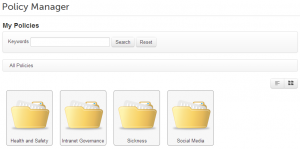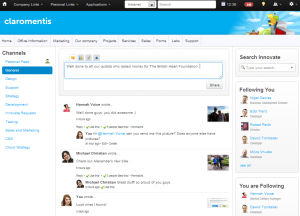Content Management
Creating an Intranet Governance Policy for CMS

An Intranet Governance Policy normally takes the form of a document but it can also be stored and shared using any information dissemination tool, ideally on your CMS intranet. It ultimately acts as a guide to all users by providing a high-level strategic view of the intranet’s purpose and a detailed overview concerning its management and maintenance.
Why do you need one?
Particular departments or employees, who weren’t necessarily involved in the initial stages of deployment, may be unsure of the overall intent of the intranet platform and how it will affect them. The intranet governance policy will therefore:
- Provide support to the intranet team
- Eliminate any confusion among end-users
- Set out good practice guidance
- Firmly establish the intranet’s role

Every Organisation is Different
You may find many examples of intranet governance policies previously generated, but your policy should be unique to your organisation. A short article on your knowledge base may be more appropriate than a lengthy document – thus, your communication method should reflect your organisation’s particular needs and culture.
Your governance policy should include:
Strategy
This section should begin with the main purposes of the intranet and what it’s intended to achieve.
Include information about why the organisation required an intranet and the issues previously experienced due to its absence or failures.
What are the next intranet stages your colleagues will experience? Is there a road-map? Sharing this information can help gain buy-in from various departments and individuals. Try to keep the number of ‘big bang’ surprises to a minimum.
To recap, here are a few important points:
-
- What were the previously identified reasons for deploying a new intranet?
- What does the business want to achieve?
- What short-term or long-term goals does it support?
- How will it positively impact employees on a day-to-day basis?
- Map out the next stages in the deployment strategy (try to incorporate your colleagues opinions and feedback into the intranet’s road-map if certain element have not been decided)
- How will you measure success – site/application analytics or KPIs?
Intranet Content
Do you have content champions from various departments within the business or is it the sole responsibility of a department or employee? Making the current or planned content creation process clear will eliminate confusion and clearly outline the procedure. It’s also appropriate to define the content strategy in relation to each application, for example, what type of content should be shared in the Knowledge Base application? If you have social applications, setting out some basic usage guidelines will reduce any apprehensions related to content sharing.

Individual and Departmental Roles
Highlight both the intranet team and their roles and responsibilities on an individual basis. State who is the first-point-of-contact for common issues, such as change requests, the creation of new intranet pages, functionality questions and adding new employees. Does each department play a key role by fulfilling certain functions?
Site Structure
This area should provide an overview of the many components or information areas within your CMS intranet. Departmental areas should also be included here and the sort of information each departmental area will provide.
For example, one of the IT department’s objectives on the intranet may be to maintain technical documentation whilst Marketing’s objective could be associated with the generation and sharing of reports.
Topics this section may include:
-
-
- Menu bar and the reasons behind its layout i.e. quick access to particularly important applications or information
- Departmental areas and their purpose
- Company and personal links
- Methods for effectively locating resources – best bets, alternative suggestions etc.
- Homepage slider and components
- Fast access buttons
- Branding guidelines
- Top bar and its contents
-
Want more expert advice on CMS software best practices?
Find additional information on content management systems and implementation tips by visiting the Business-Software.com CMS software resource center. If you’re ready to browse solutions, download one of our free CMS software comparison reports to review leading industry solutions.






